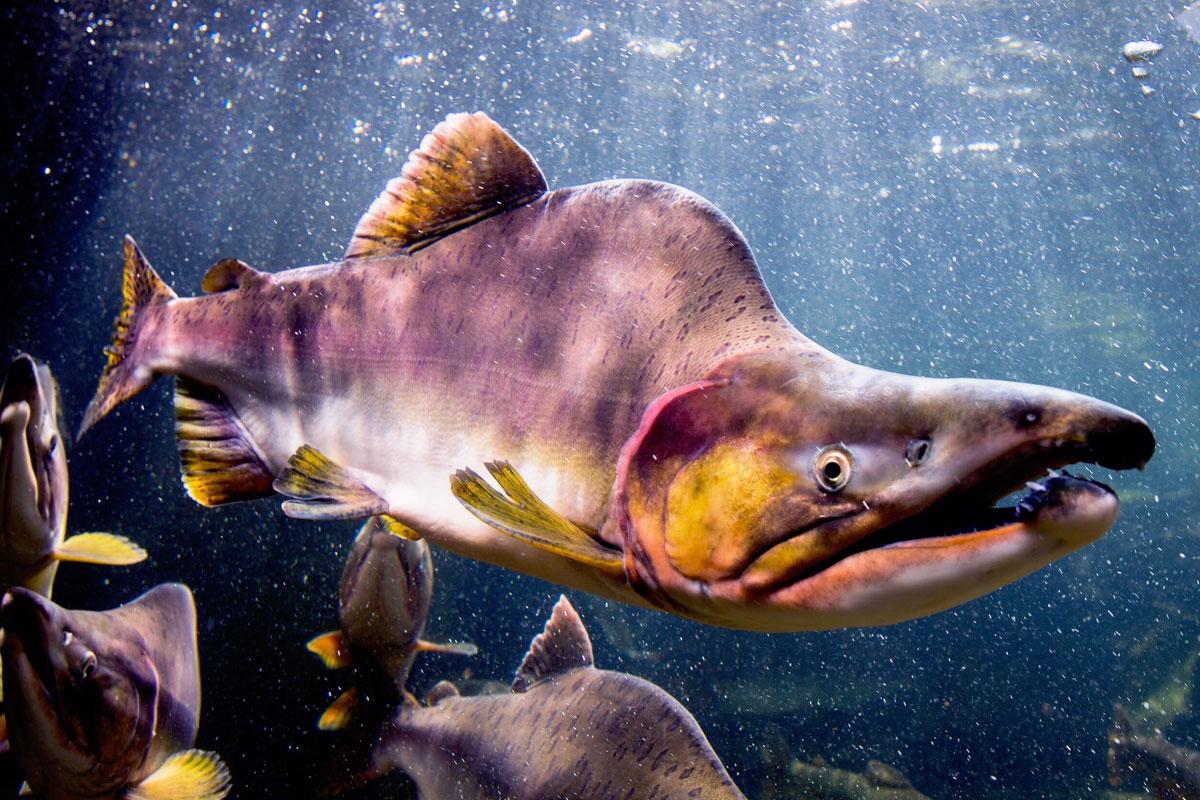Pink salmon are one of the most abundant and commercially important salmon species found along the Pacific coast of North America. Identifying their unique features and appearance can help fishermen, nature enthusiasts, and salmon managers better understand and protect these important fish. In this article, we’ll explore what pink salmon look like in both their ocean and spawning phases so you can easily recognize them.
Appearance of Pink Salmon at Sea
When pink salmon are out at sea feeding and maturing, they have a distinct steel blue to blue-green back with silvery, metallic sides and a white belly. These colors help camouflage them from above and below while in the open ocean. In addition to their coloring, pink salmon have these identifying features in their ocean phase:
- Very small scales compared to other salmon species of similar size
- Large oval spots on both lobes of the tail fin
- Prominent large black spots on their back and dorsal fin
- A mouth that is white on the inside with a black gumline
- Very small or almost no teeth, and no teeth on the tongue
- A pointed lower jaw that overlaps the upper jaw
- A slender body shape built for fast, long-distance swimming
Young pink salmon migrating out to sea are slim and completely silver, making them difficult to distinguish from other salmon juveniles. But once they’ve spent time feeding in the ocean, pink salmon develop the distinctive large spots on their tail and back that make them easier to identify.
What Spawning Pink Salmon Look Like
When pink salmon return to their natal rivers and streams to spawn, the males and females both undergo dramatic physical and color changes.
Spawning male pink salmon develop a pronounced humped back and extremely large teeth. Their backs turn a dark brown or black color while their bellies remain bright white. The large spots on their tails and backs remain, creating a striking contrast against their darkened spawning coloration. The dramatic changes in mature male pink salmon during the spawning phase have earned them the nickname “humpies”.
Females also darken but not to the same extent as the males They turn an olive green color on the back with dusky grey and lavender patches along the sides. Their bellies remain pale white or cream They also retain the distinctive large oval spots on the tail and back. During the spawning act itself, females develop an abrasion on their back called a “spawning rash”, caused by digging nests in the gravel river bottom.
Range and Habitat
Pink salmon have the widest natural distribution of any salmon species. They occur along the Pacific coast from Korea and Russia in Asia to California in North America. In North America, significant reproducing populations of pink salmon are found from Puget Sound in Washington state all the way around the Alaska coast and throughout the Aleutian Islands.
While pink salmon sometimes stray into large rivers, they generally spawn in streams close to the ocean. Adults migrate from a few miles up to 40 miles inland to reach spawning habitats. Most pink salmon spawning grounds are located in lower river reaches within 30 miles of the river mouth.
Pink salmon prefer to spawn in areas with clean gravel, moderate to fast current speeds, and cool water temperatures. Estuaries, intertidal zones, and stream mouths that offer easy access to ocean feeding grounds are prime real estate for pink salmon juveniles.
Unique Life Cycle
Pink salmon have a fixed, rigid two-year life span. This results in genetically distinct odd-year and even-year populations that return on alternating years. Rivers often have predominantly odd or even-year returns, with one generation outnumbering the other. But both lines continue to spawn in the same habitat on their separate two year cycles.
The clockwork lifespan of pink salmon enables managers to make reliable forecasts of run strength and set harvest levels year after year. Understanding what pink salmon look like throughout their ocean phase, return migration, and spawning can help manage this valuable species into the future.
So now that you know what to look for, you’ll be able to readily identify pink salmon at any stage and appreciate their role in the Pacific ecosystem! Let us know in the comments if you have any other questions about recognizing these abundant salmon.

Is Pink Salmon Sustainable?
U.S. wild-caught pink salmon is a smart seafood choice because it is sustainably managed and responsibly harvested under U.S. regulations.
Fresh from late summer to fall, and frozen and canned year-round.
U.S. wild caught from Alaska, Washington, and Oregon.
Pink salmon has a low oil content so it’s generally lean and mild-flavored.
Softer meat than most salmon with a small flake.
Pink salmon’s meat is pale pink and lacks the orange tint of other salmon species.
Pink salmon is low in sodium and is a good source of omega-3 fatty acids, protein, niacin, vitamin B12, and selenium.
Pink Salmon Research in Alaska
Our work to forecast salmon harvests, assess the impact of commercial fisheries on salmon, and evaluate how salmon populations respond to environmental changes enable us to estimate abundance and trends for pink salmon in Alaska.
Red or Pink Salmon? What’s the Difference?
FAQ
How to identify pink salmon?
Is pink salmon a good fish to eat?
Pink salmon are also very good to eat when caught in the ocean, or just returning to spawn. Their pale flesh has a mild taste and excellent texture.
What is the pink fish that looks like salmon?
Several types of fish share a pinkish-orange flesh similar to salmon. These include steelhead trout, trout, Arctic char, and pink salmon.
